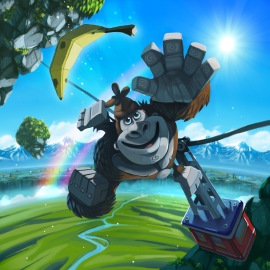Let’s start out by getting some background on Electric Pixel Factory. How many people work behind the logo currently, and is this everyone’s first videogame project, or are one or more members seasoned industry veterans already? Also, how would you describe the studio’s creative vision – what kind of experiences do you want to bring to iOS gamers?
Dean: Firstly we would like to say a big “hello” to all of your readers. There are currently three of us, so just for a quick introduction, I’m Dean, and I was responsible for the art direction on the project and I produced most of “the pretty stuff” you get to see on screen.
EU: I’m the programmer of the bunch. I also did game design and level setup and I wrote the music for the game too, which was especially fun!
Dave: I did all the 3D art, 2D special effects, Gorilla sprite animations, some level design work and handled all the business-related matters including PR and Marketing.
EU: We’ve actually all got a few years’ worth of experience each working in the UK games industry, first and third party, and we’ve worked on several AAA console titles. I should add that two of them even won a BAFTA!
Dean: We decided about a year ago now that the casual gaming scene was becoming a mouth watering prospect and it was time to act. We thought that we could have a lot of fun creating something a bit out of the ordinary, in a climate where people embrace something new and a bit “wacky.”
Dave: Yeah, easily the best aspect of being part of a small indie development team is that we call the shots and we decide what gaming experience we want to bring to the gamers. I see us as a company that wants to stand out from the crowd! We want to deliver high quality, fun and innovative titles that look, sound and play like nothing seen before! We certainly don’t want to base our games on any sort of template just because everyone else is doing it.
 How did you end up deciding that your studio’s first game would be about a giant gorilla riding a ski lift? There must be an interesting story there – did the studio form around this idea to begin with, or was it the result of a brainstorming session once the team had assembled?
How did you end up deciding that your studio’s first game would be about a giant gorilla riding a ski lift? There must be an interesting story there – did the studio form around this idea to begin with, or was it the result of a brainstorming session once the team had assembled?
Dave: Gorilla Gondola was one of EU’s crazy ideas. When I first heard about it I started laughing and thought that it was a ridiculous suggestion.
EU: Yes, you can thank my girlfriend for that. She crafted an advent calendar out of a ski gondola toy from a charity shop for me, and when I looked at it I thought that bouncing one of these through danger could be a fun game. In my head, a gorilla seemed the most obvious thing that could be the input making it bounce. I think that scene with James Bond jumping around on a gondola above Rio de Janeiro in Moonraker was in my head too. So the basic idea was formed within five seconds, really. Then we just built a prototype and kept adding cool stuff.
Dean: Actually, we had several more game ideas floating around, one involving a vegetable in a top hat controlling the weather. It was a fun time sitting down with a sketch pad and a pint brainstorming this kind of stuff! In the end, Gorilla Gondola just had a certain ring to it.
 Which game engine/SDK/programming language did you use to build Gorilla Gondola? Did you try alternatives and found it best to stick with this one over the long haul, or did you know which option had all the qualities you were looking for right from the start?
Which game engine/SDK/programming language did you use to build Gorilla Gondola? Did you try alternatives and found it best to stick with this one over the long haul, or did you know which option had all the qualities you were looking for right from the start?
EU: We’re using our own engine purpose-built for 2D games.
Dean: We call it EU-Engine 4, to one-up Unreal Engine 3.
EU: It all started off in XNA and C# on the PC actually, because in the beginning we didn’t have any phone or Mac hardware. The leap to Windows Phone was quite obvious then, as XNA code runs on supported platforms with little or no modifications. Porting to iOS is a bit more involved, but C# translates to C++ not too badly. Objective C is only used where there is no other option, i.e., as the glue between iOS and the game code.
I’ve not really looked at using any existing engines because for me, it’s also an engineering exercise to write everything from the ground up — it’s fun, believe it or not. Also, never underestimate the benefits you get from knowing your engine inside out. If something doesn’t work, you can usually figure out the problem rather quickly, and really, you only have yourself to blame. And then there’s portability. Sure, I could use a built-in font rendering library on Windows Phone 7, but when that library isn’t available on iOS I have to write my own stuff anyway.



